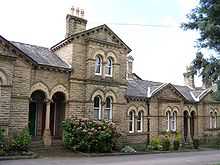Henry Francis Lockwood
Henry Francis Lockwood (1811–1878) was an influential architect, born at Doncaster on 18 September 1811. His father and grandfather (both named Joseph) were mayors of Doncaster. He married Emma Day (1810–1882) whose great uncle, Charles Day (boot blacking manufacturer), made a fortune through the Day and Martin company. Their ten children were all given Day as a middle name: Emma (1833), Charles (1834), Henry (1836), Arthur (1838), Rosa (1840), Horace (1842), Frederick (1845), Florence (1849), Francis (1851), and Blanche (1853). Through son Francis, Henry Francis Lockwood was the great grandfather of the film actress Margaret Lockwood (1916–1990). Henry Francis Lockwood was also the uncle of Sir Frank Lockwood QC (1846–1897). A more distant cousin was Sir Joseph Flawith Lockwood (1904–1991) the Chairman of EMI who signed The Beatles.
Henry Francis Lockwood was articled in London to Peter Frederick Robinson, and given supervision of the extensions to York Castle for which Robinson had been appointed architect in 1826. In 1834 Lockwood published jointly with Adolphus H Cates, The History and Antiquities of the Fortifications to the City of York.
In 1834 Lockwood set up a practice in Hull, where in partnership with Thomas Allom he designed a number of Neo-classical buildings, such as Trinity House (1839), extensions to the Royal Infirmary (1840) and Great Thornton Street Church (1843). The partnership with Allom ended by mutual consent on 30 December 1843.[1]
In 1849 Lockwood moved to Bradford to form a partnership with Richard and William Mawson. Lockwood and Mawson designed some of the most distinguished buildings in Bradford, including St George's Hall (1851-2), the Venetian Gothic Wool Exchange (1864-7), and the Continental Gothic Revival City Hall (1869–73). They also laid out and designed the mill, model town and church at Saltaire (1851–76), all in an Italianate Classical style. At the time, Saltaire was one of the most important examples of a philanthropic industrial and housing development in the world. Lockwood is mentioned in most accounts of Sir Titus Salt and Saltaire. Lockwood and Mawson also submitted designs in many competitions, including the contest for the Law Courts in the Strand, London (1866–67).[2]
After 1871, Lockwood moved to London where he designed the Methodist City Temple (1873), Holborn Viaduct (1873-4), the Church of St Stephen, Cowbridge Park, East Twickenham (1874) and the Civil Service Stores, Strand (1876). Lockwood and Mawson were also appointed architects for the new buildings at Merchant Taylors' School, Crosby (1874). H F Lockwood was the first President of the BSAS when it was founded in 1874.[3]
Henry Lockwood and his family lived for many years at Nun Wood, Apperley Bridge, Yeadon, but after 1871 moved to Heron Court, Richmond, Surrey, where he died aged 66 on Sunday, 21 July 1878.[4] He is buried in Kensal Green Cemetery (a few metres behind Blondin of Niagara Falls fame). Emma Lockwood died aged 72 on Christmas Day 1882[5]
Gallery of architectural work
-

Bradford City Hall
-

Bradford Wool Exchange
-

The interior, Bradford Wool Exchange
-
.jpg)
Detail St. George's Hall, Bradford
-

Rear, St. George's Hall, Bradford
-

Interior, St. George's Hall, Bradford
-

Salt's Mill, Saltaire
-
Congregational Church, Saltaire
-

Victoria Hall, Saltaire
-

Almshouses, Saltaire
-
Former Hospital, Saltaire
-

Typical housing, Saltaire
References
- ↑ The London Gazette, 2 January 1844
- ↑ Port, M.H., The New Law Courts Competition, 1866-67. Architectural History, Vol. 11, (1968), pp. 75-120, which includes reproductions of all the entries. Lockwood's drawing was thought "monotonous" and did not win.
- ↑ "The Architects of Bradford". Retrieved 2009-11-29.
- ↑ Obituary in The Leeds Mercury, 24 July 1878.
- ↑ The Times, 3 January 1883.
|

